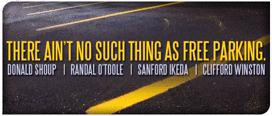Dr. Shoup and I agree that governments should eliminate minimum-parking requirements and charge market rates for on-street and other public parking. That said, we have two areas of disagreement.
First, Shoup thinks that these changes would have dramatic effects on the amount of driving people do. I think the effects would be trivial, and that the larger effects would be to discourage people from traveling to high-density areas (such as downtowns) where parking is currently below market value. Instead they would go to low-density areas where the market rate for parking is zero. In other words, his policies would promote what planners derisively call “sprawl.” But it really doesn’t matter who is right; let’s fix the policies and find out.
Second, I worry that many cities are using Shoup’s research to justify the imposition of maximum-parking limits in many zones, while Shoup thinks this threat is unimportant.
It doesn’t take much of a web search to find cities that are imposing maximum-parking limits in at least some zones in the city. Many of these cite Shoup’s work on the evils of minimum-parking requirements, but then compound those evils by proposing the reverse.
John Charles, of Oregon’s Cascade Policy Institute, has documented that land next to the stations along Portland’s light-rail lines sometimes remains undeveloped years after the rail lines open. The reason, Charles has shown, is that the city has imposed maximum-parking limits, reasoning that people living next to the rail stations will ride the train rather than drive. Developers, however, know that developments with limited parking end up with high-vacancy rates.
Many of the cities proposing maximum-parking limits also cite a paper by Todd Litman of the Victoria Transport Policy Institute. Litman argues strongly for maximum-parking limits and cites five of Shoup’s papers. While Shoup is not responsible for another policy analyst’s work, I hope he would let potential readers of Litman’s paper know that his opposition to minimum-parking requirements does not equate to support for maximum-parking limits.

